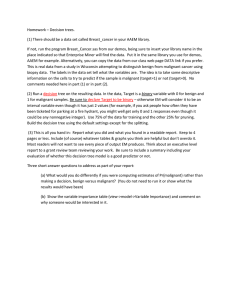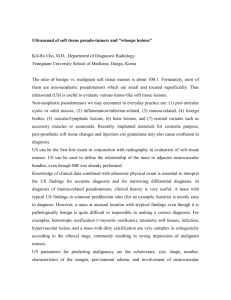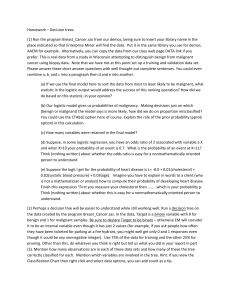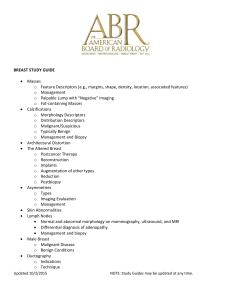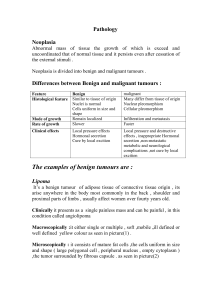Indeterminate fine-needle aspiration of the breast
advertisement
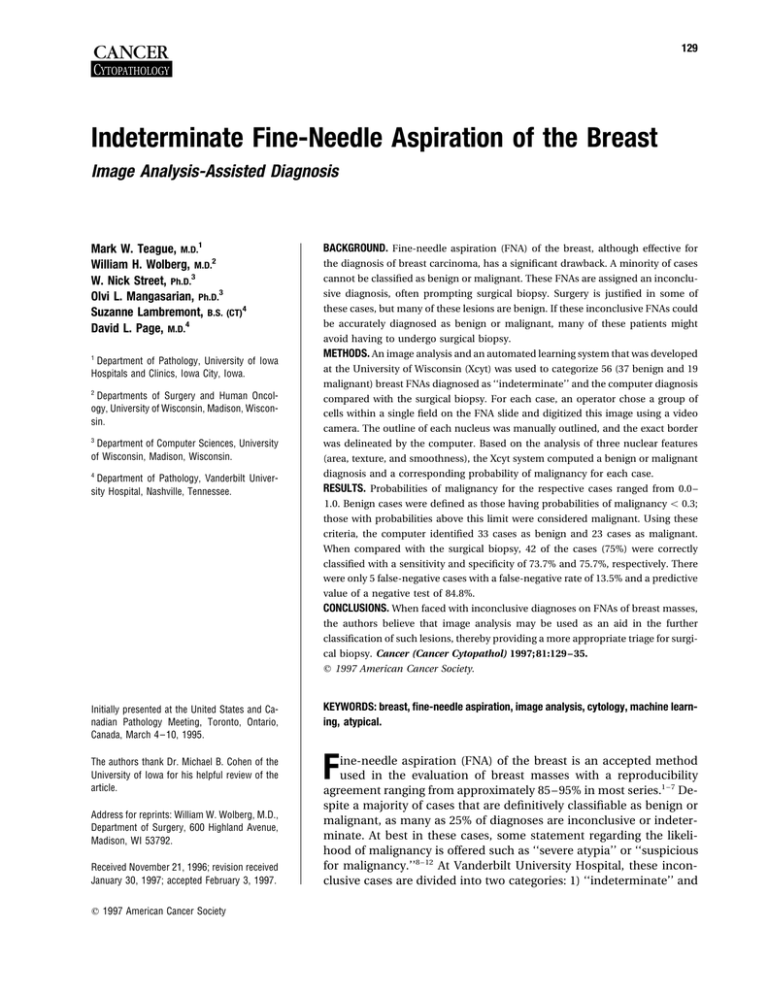
129 CANCER CYTOPATHOLOGY Indeterminate Fine-Needle Aspiration of the Breast Image Analysis-Assisted Diagnosis Mark W. Teague, M.D.1 William H. Wolberg, M.D.2 W. Nick Street, Ph.D.3 Olvi L. Mangasarian, Ph.D.3 Suzanne Lambremont, B.S. (CT)4 David L. Page, M.D.4 BACKGROUND. Fine-needle aspiration (FNA) of the breast, although effective for the diagnosis of breast carcinoma, has a significant drawback. A minority of cases cannot be classified as benign or malignant. These FNAs are assigned an inconclusive diagnosis, often prompting surgical biopsy. Surgery is justified in some of these cases, but many of these lesions are benign. If these inconclusive FNAs could 1 Department of Pathology, University of Iowa Hospitals and Clinics, Iowa City, Iowa. 2 Departments of Surgery and Human Oncology, University of Wisconsin, Madison, Wisconsin. 3 Department of Computer Sciences, University of Wisconsin, Madison, Wisconsin. 4 Department of Pathology, Vanderbilt University Hospital, Nashville, Tennessee. be accurately diagnosed as benign or malignant, many of these patients might avoid having to undergo surgical biopsy. METHODS. An image analysis and an automated learning system that was developed at the University of Wisconsin (Xcyt) was used to categorize 56 (37 benign and 19 malignant) breast FNAs diagnosed as ‘‘indeterminate’’ and the computer diagnosis compared with the surgical biopsy. For each case, an operator chose a group of cells within a single field on the FNA slide and digitized this image using a video camera. The outline of each nucleus was manually outlined, and the exact border was delineated by the computer. Based on the analysis of three nuclear features (area, texture, and smoothness), the Xcyt system computed a benign or malignant diagnosis and a corresponding probability of malignancy for each case. RESULTS. Probabilities of malignancy for the respective cases ranged from 0.0– 1.0. Benign cases were defined as those having probabilities of malignancy õ 0.3; those with probabilities above this limit were considered malignant. Using these criteria, the computer identified 33 cases as benign and 23 cases as malignant. When compared with the surgical biopsy, 42 of the cases (75%) were correctly classified with a sensitivity and specificity of 73.7% and 75.7%, respectively. There were only 5 false-negative cases with a false-negative rate of 13.5% and a predictive value of a negative test of 84.8%. CONCLUSIONS. When faced with inconclusive diagnoses on FNAs of breast masses, the authors believe that image analysis may be used as an aid in the further classification of such lesions, thereby providing a more appropriate triage for surgical biopsy. Cancer (Cancer Cytopathol) 1997;81:129–35. q 1997 American Cancer Society. Initially presented at the United States and Canadian Pathology Meeting, Toronto, Ontario, Canada, March 4–10, 1995. KEYWORDS: breast, fine-needle aspiration, image analysis, cytology, machine learning, atypical. The authors thank Dr. Michael B. Cohen of the University of Iowa for his helpful review of the article. F Address for reprints: William W. Wolberg, M.D., Department of Surgery, 600 Highland Avenue, Madison, WI 53792. Received November 21, 1996; revision received January 30, 1997; accepted February 3, 1997. ine-needle aspiration (FNA) of the breast is an accepted method used in the evaluation of breast masses with a reproducibility agreement ranging from approximately 85 – 95% in most series.1 – 7 Despite a majority of cases that are definitively classifiable as benign or malignant, as many as 25% of diagnoses are inconclusive or indeterminate. At best in these cases, some statement regarding the likelihood of malignancy is offered such as ‘‘severe atypia’’ or ‘‘suspicious for malignancy.’’8 – 12 At Vanderbilt University Hospital, these inconclusive cases are divided into two categories: 1) ‘‘indeterminate’’ and q 1997 American Cancer Society / 7303$$1018 03-26-97 11:20:37 ccyta W: Can Cyto 130 CANCER (CANCER CYTOPATHOLOGY) April 25, 1997 / Volume 81 / Number 2 2) ‘‘suspicious for malignancy,’’ in which the latter indicates a higher probability of malignancy. Computer image analysis has been used successfully in the diagnosis of breast FNAs.10,13 – 19 However, few studies have focused on the use of image analysis in the diagnosis of inconclusive cases.8,9 The authors believe that in these cases image analysis has much to offer, making possible a more definitive classification than is currently available by traditional light microscopy. To test this hypothesis, the authors evaluated by image analysis 56 breast FNAs diagnosed as ‘‘indeterminate’’ and compared the cytometry diagnosis to the surgical biopsy. This category of patients was chosen rather than the ‘‘suspicious for malignancy’’ category because patients from the former group are more likely to have benign lesions. Therefore should image analysis indicate a benign diagnosis, these patients might be managed by more conservative care. MATERIALS AND METHODS Eighty-five breast FNAs, all from female patients, were diagnosed as ‘‘indeterminate’’ (approximately 7% of all breast FNAs) at Vanderbilt University between January 1992 and April 1994. The criteria for classification of an FNA as ‘‘indeterminate’’ included increased cellularity, decreased cellular cohesion, and the presence of only a few myoepithelial cells. Of these total cases, 29 could not be included in the study either because there was no subsequent surgical biopsy or no FNA slides were available. This left a total of 56 cases, each having a corresponding surgical biopsy, that formed the basis of the study. Palpable breast masses had been aspirated with 22- to 25-gauge needles. The smears were prepared using one of two methods. The first, the two-slide pullapart method, involves the approximation of two slides that are pulled apart horizontally, resulting in a smearing of the interposed cellular fluid.20 The second technique is similar to the first, with the exception that the slides are pulled apart in a vertical motion. Although cells are dispersed by the apposition of the slides, the latter technique has the disadvantage of limited smearing of the cells, which may not provide a sufficient monolayer of cells necessary for nuclear cytometry.21,22 After fixation in 95% ethanol, the slides were stained with hematoxylin and eosin. For a more accurate comparison with FNAs, malignant surgical biopsy diagnoses were divided into two categories: 1) low grade lesions that included ductal noncomedocarcinoma in situ and Grade 1 invasive carcinomas and 2) high grade lesions that included ductal comedocarcinoma in situ and Grades 2 and 3 invasive carcinoma. Atypical hyperplasias and lobular / 7303$$1018 03-26-97 11:20:37 carcinoma in situ were considered benign for the purpose of this study.23 Grading of invasive carcinomas was performed using a modification of the BloomRichardson method.24 The image analysis system used, called Xcyt, was developed at the University of Wisconsin and has been used to accurately classify breast FNAs. A detailed description of this system and its accuracy has been previously reported.25,26 For each case, a single image projected through a 163 objective was generated using a JVC TK-1070U color video camera and captured by a Computer Eyes/RT color framegrabber board (Digital Vision, Inc., Dedham, MA). The image chosen was one representative of the most atypical-appearing nuclei on the slide. Using a mouse input device and computer monitor, the observer, an operator experienced both with the interpretation of breast FNAs and the image analysis system, manually traced the individual outlines of 10 – 20 nuclei within the video-captured image to provide a representative sample. The current software used is capable of storing data from only one high-power field per case, which limits the number of nuclei that can be analyzed. Nuclear size, shape, and texture for each nucleus were represented by ten computer-generated nuclear characteristics, each of which had a corresponding mean value, worst value (mean of the three largest values), and standard error. From these 30 nuclear characteristics, 3 (worst area, mean texture, and worst smoothness) were then used to classify each case as either benign or malignant with a corresponding probability of malignancy ranging from 0.0 – 1.0. RESULTS All cases with their corresponding probabilities of malignancy and surgical diagnoses are presented in Table 1. Cases with probabilities of malignancy õ 0.3 were considered benign, and those with probabilities of ¢0.3 were considered malignant. This cutoff value was determined by a receiver operator characteristic curve (Fig. 1) as that value that provided the highest combined sensitivity and specificity (73.7% and 75.7%, respectively). When compared with the surgical biopsy, the cytometry diagnosis correctly classified 42 of the 56 cases (75%) as either benign or malignant. The predictive values of a positive and negative test were 60.9% and 84.8%, respectively (Table 2). All malignant surgical biopsy diagnoses were mammary carcinomas. Five cases were false-negative diagnoses, giving a false-negative rate of 13.5%. Tumors removed at surgery from three of the false-negative cases were low grade carcinomas (Fig. 2). Slides from all five cases were prepared by vertical smearing, which may not yield uniformly monolayer sheets and thus may affect ccyta W: Can Cyto Fine-Needle Aspiration of Breast/Teague et al. 131 TABLE 1 Image Analysis and Surgical Diagnoses by Patient No. Age (yr) Surgical Bx Image analysis Probabil malig 1 2 3a 4 5 6a 7 8 9a 10 11 12 13 14 15 16 17 18a 19 20 21 22 23 24 25 26 27 28a 29 30 31 32 33 34 35b 36 37b 38b 39b 40b 41b 42 43b 44b 45 46 47b 48 49 50 51 52 53 54 55 56 57 46 43 59 44 49 57 52 51 32 61 78 34 41 41 37 42 47 22 37 40 70 64 44 34 26 42 48 36 34 45 48 73 68 32 45 39 38 45 51 36 67 46 71 83 51 52 49 50 54 39 56 36 54 46 47 Benign Benign IDC HG Benign Benign ILC LCIS Benign IDC HG Benign ADH Benign Benign Benign Benign ALH Benign IDC LG Benign Benign Benign ALH Benign Benign Benign Benign Benign IDC LG Benign Benign Benign Benign Benign DCIS LG Benign IDC LG Benign Benign Benign Benign Benign IDC LG Benign Benign IDC LG ILC Benign IDC LG IDC HG IDC HG IDC HG DCIS HG IDC HG IDC HG IDC HG IDC HG Benign Benign Benign Benign Benign Benign Benign Benign Benign Benign Benign Benign Benign Benign Benign Benign Benign Benign Benign Benign Benign Benign Benign Benign Benign Benign Benign Benign Benign Benign Benign Benign Benign Malignant Malignant Malignant Malignant Malignant Malignant Malignant Malignant Malignant Malignant Malignant Malignant Malignant Malignant Malignant Malignant Malignant Malignant Malignant Malignant Malignant Malignant Malignant 0 0.01 0.01 0.01 0.01 0.01 0.02 0.02 0.02 0.02 0.02 0.02 0.02 0.03 0.03 0.03 0.03 0.03 0.03 0.03 0.04 0.04 0.05 0.06 0.06 0.07 0.08 0.09 0.13 0.16 0.17 0.19 0.26 0.31 0.35 0.38 0.42 0.44 0.45 0.48 0.52 0.53 0.54 0.66 0.9 0.9 0.95 0.97 0.99 1 1 1 1 1 1 1 FIGURE 1. Receiver operator characteristic curve. Data point labels refer to respective probabilities. TABLE 2 Comparison of Cases by Method of Diagnosis Surgical biopsy 03-26-97 11:20:37 Malignant Benign Total Malignant Benign Total 14 5 19 9 28 37 23 33 56 Sensitivity: 73.7%; specificity: 75.7%, positive predictive value: 60.9%; negative predictive value: 84.8%. nuclear cytometry. The method of smearing is also important because the training set on which the diagnostic algorithm is based was prepared using the horizontally smeared pull-apart slide technique. Nine cases were false-positive diagnoses. Surgical biopsy of one of these cases revealed lobular units containing highly atypical, elongated cells with increased nuclear:cytoplasmic ratios, irregular nuclear borders, and cell overlap reminiscent of cells observed in carcinoma. However, the lobular architecture was unaltered, signifying a benign diagnosis (Fig. 3). DISCUSSION Bx: biopsy; Probabil malig: probability of malignancy; a: false-negative; b: False-positive; ALH: atypical lobular hyperplasia; ADH: atypical ductal hyperplasia; DCIS: ductal carcinoma in situ; HG: high grade; IDC: invasive ductal carcinoma; ILC: invasive lobular carcinoma; LCIS: lobular carcinoma in situ; LG: low grade. / 7303$$1018 Image analysis One limitation of FNA in the evaluation of breast masses is that all cases cannot be definitively classified as benign or malignant. Approximately 50 – 70% of these inconclusive cases are benign by surgical biopsy.2,7,9,12,27 – 32 Were an accurate means of diagnosis available, many of these women might avoid undergoing unnecessary surgery. Given the spectrum of lesions within the breast and their individual natural histories, a simplified approach to triaging diagnoses is only an initial classification of breast neoplasia. Nevertheless, when faced with the question of whether to proceed to surgical biopsy, a degree of diagnostic and management stratification is necessary. The results of the current study indicate that image analysis can be used as an effective adjunct in the classification of such inconclusive breast FNAs. ccyta W: Can Cyto 132 CANCER (CANCER CYTOPATHOLOGY) April 25, 1997 / Volume 81 / Number 2 FIGURE 2. Invasive carcinoma of no special type. This tumor, diagnosed as benign by image analysis, has low grade features of small nuclear size, inconspicuous nucleoli, and uniform chromatin texture that are strikingly similar in the (A) fine-needle aspiration and (B and C) surgical biopsy specimens (H&E, magnification A: 1500, B: 1125, and C: 1475). Applications for image analysis in breast neoplasia include estrogen receptor quantitation, nuclear grading, prognostication, and ploidy analysis.19,33 – 38 Reports of computer-aided image analysis for the diagnosis of breast FNAs are limited, with a variable cytohistologic concurrence of 64 – 100%.14,16,18,33 Detweiler et al. were able to correctly classify 16 of 18 breast aspirates using high resolution single cell image analysis. Both of the misclassified cases were inconclusive by FNA and malignant by histology.14 A contrast gradient index was used by Spina et al. to correctly classify 100% of 35 breast aspirates.39 The current study differs somewhat from most others in that only that category of breast aspirates diagnosed as ‘‘indeterminate’’ by traditional light microscopy was analyzed. Other series have included FNAs with benign, atypical, suspicious, and malignant diagnoses. Boon et al. analyzed 33 inconclusive breast FNAs by image analysis and were able to correctly classify 48% of the malignant and all of the benign tumors.16 Among the 18 cases analyzed by Detweiler et al., there was a false-negative rate of 25% among the eight ‘‘suspicious’’ diagnoses by FNA.14 Therefore, the false-negative rate of 13.5% in the current study is exceptional given the category of patients analyzed. / 7303$$1018 03-26-97 11:20:37 The false-negative rate of FNA by traditional light microscopy ranges from 2 – 10%.11,28,40 – 43 The authors do not suggest that the results of this technology be relied upon exclusively, but rather used in conjunction with other clinical data such as physical examination and mammogram. The low grade nuclear features in three of the five false-negative cases in the current study may have contributed to underdiagnosis using cytometry. Small nuclear size, particularly in lobular carcinoma, has been noted by others to be problematic in the diagnosis of malignancy.14,44 In addition, some of the falsenegative cases in this study may have been lesions inadequately sampled by FNA. The number of misclassified cases in the current study might be decreased by stricter exclusion criteria for inadequate smears, including the use of a uniform smearing technique and preferably the horizontal pull-apart smearing technique. Given that all patients with inconclusive diagnoses will have some additional follow-up to exclude carcinoma, the authors believe that the sensitivity of 73.7% found in this study does not invalidate the test. Of greater value is the predictive value of a negative test (84.8% in the current study), which is the likelihood ccyta W: Can Cyto Fine-Needle Aspiration of Breast/Teague et al. 133 FIGURE 3. (A) Fine-needle aspiration (FNA) and (B and C) surgical biopsy specimens from a false-positive case. Nuclear pleomorphism and hyperchromasia among these small, angular, epithelial clusters in the FNA may help explain the malignant diagnosis rendered by image analysis. Although the architecture of the lobular unit indicates it is benign, the nuclei are deceptively atypical (H&E, original magnification A: 1500, B: 1125, and C: 1475). that a patient with a negative test does not have malignant disease.45 Depending on the clinical impression, these patients might be followed without immediate surgical biopsy. The cytology of one of the false-positive cases in the current study contained marked nuclear atypia that may help to explain the malignant diagnosis rendered by image analysis (Fig. 3). Although the smear was prepared by a horizontal pull-apart technique, the spindled nature of the cells was not wholly artifactual. Similar-appearing nuclei were noted on the surgical biopsy. Based on the combination of clinical suspicion and FNA diagnosis, these nine patients underwent surgical biopsy. Therefore, biopsy on the basis of a malignant image analysis diagnosis would not have been an additional procedure. One will notice in Table 1 that between the probabilities of malignancy of 0.3 and 0.9 lie 11 cases that include most of the false-negative diagnoses. To increase the positive predictive value of the test, one might consider these cases inconclusive by cytometry and exclude them from statistical analysis. This would provide a somewhat lower sensitivity of 68.8%, but the predictive value of a positive test increases to 91.7%. Realizing that a small percentage of diagnoses are al- / 7303$$1018 03-26-97 11:20:37 ways inconclusive by traditional FNA, one might suggest a similar approach to image analysis diagnosis. Currently, the authors’ image analysis diagnoses are based on only one high-power field per case (10 – 20 nuclei), which is the limitation of the system’s software storage capacity. This disadvantage of limited sampling is mitigated somewhat by first visually selecting the worst-appearing nuclei that occur within a single field. Other investigators have recommended evaluation of up to 250 nuclei for morphometric studies.33,46,47 Perhaps by examining multiple fields the percentage agreement of the authors’ image analysis-assisted system could be improved. Currently, the authors are making software revisions to allow for such. Not only would this allow for a better sampling representation of the tumor, but it might also compensate for image artifacts. In addition, this system uses only individual nuclear analysis for diagnosis. Although contextual features are used in conjunction with individual cell features for visual diagnosis, others have found that these add little to image analysis diagnosis.14 The Xcyt system’s operator learning curve is relatively simple and depends chiefly on the mastery of two steps: 1) selection of the nuclei that are to be ccyta W: Can Cyto 134 CANCER (CANCER CYTOPATHOLOGY) April 25, 1997 / Volume 81 / Number 2 analyzed and 2) outlining them, which requires dexterity using a mouse input device. Accomplishment of the first is aided by some expertise in cytopathology, but this is not required. The authors’ system has the technical advantage of requiring no special staining such as Feulgen; rather, analyses are performed using a standard hematoxylin and eosin stain. However, it should be noted that staining was performed by hand by more than one person and therefore may not be uniform from case to case. Improved results might be achieved using automated staining as well as alternative preparatory techniques to provide more uniform cell layering. Others have performed similar analyses on stains used routinely in FNA cytology including hematoxylin and eosin, May-Grünwald-Giemsa, and Papanicolaou.14,18,37 The original set of slides used to train the system was comprised of 569 consecutive breast FNAs that contained epithelial cells. These included the entire spectrum of aspirates acquired in practice, most of which were easily classified as benign or malignant.25 This separate set of 56 cases provides additional, difficult samples for retraining, thus increasing the system’s robustness. Currently, the system’s software is not developed to the point of market feasibility. When this and other similar changes have been made, a study addressing cost-effectiveness would be appropriate. It has been demonstrated in the current study that automated image analysis may be applied to indeterminate breast FNAs as an adjunct in distinguishing benign from malignant lesions. Patients with such lesions may thereby be more appropriately triaged for needed surgical intervention. REFERENCES 1. 2. 3. 4. 5. 6. 7. 8. Orell SR, Sterrett GF, Max N-I, Whitaker D, Lindholm K. Manual and atlas of fine needle aspiration cytology. New York: Churchill-Livingstone, 1992:130–69. Oertel YC. Fine needle aspiration of the breast. Boston: Butterworths, 1987:187–96. Frable WJ. Thin needle aspiration biopsy. A personal experience of 469 cases. Am J Clin Pathol 1976;65:168–82. Frable WJ. Needle aspiration biopsy of the breast. Cancer 1984;53:671–6. Silverman JF. Breast. In: Bibbo M, editor. Comprehensive cytology. Philadelphia: W.B. Saunders Company, 1991:762– 3. Lannin DR, Silverman JF, Pories WJ, Walker C. Cost effectiveness of fine needle biopsy of the breast. Ann Surg 1986;203:474–80. Kline TS, Joshi LP, Neal HS. Fine needle aspiration of the breast. Diagnostic pitfalls. A review of 3545 cases. Cancer 1979;44:1458–64. Layfield LJ, Chrischilles EA, Cohen MB, Bottles K. The palpable breast nodule: a cost-effectiveness analysis of alternate diagnostic approaches. Cancer 1993;72:1642–51. / 7303$$1018 03-26-97 11:20:37 9. 10. 11. 12. 13. 14. 15. 16. 17. 18. 19. 20. 21. 22. 23. 24. 25. 26. 27. ccyta Casey TT, Rodgers WH, Baxter JW, Sawyers JL, Reynolds VH, Page DL. Stratified diagnostic approach to fine needle aspiration of the breast. Am J Surg 1992;163:305–11. King EB, Chew KL, Duarte L, Hom JD, Mayall BH, Miller TR, et al. Image cytometric classification of premalignant breast disease in fine needle aspirates. Cancer 1988;62:114–24. Sheikh FA, Tinkoff GH, Kline TS, Neal HS. Final diagnosis by fine-needle aspiration biopsy for definitive operation in breast cancer. Am J Surg 1987;154:470–4. Petersen JL, Koolman-Schellekens MA, van de Peppel-van de Ham T, van Heerde P. Atypia in fine-needle aspiration cytology of the breast: a histologic follow-up study of 301 cases. Semin Diagn Pathol 1989;6:126–34. Wied GL, Bartels PH, Bibbo M, Dytch HE. Image analysis in quantitative cytopathology and histopathology. Hum Pathol 1989;20:549–71. Detweiler R, Zahniser DJ, Garcia GL, Hutchinson M. Contextual analysis complements single-cell analysis in the diagnosis of breast cancer in fine needle aspirates. Anal Quant Cytol Histol 1988;10:10–5. Becker RL, Mikel UV, O’Leary TJ. Morphometric distinction of sclerosing adenosis from tubular carcinoma of the breast. Anal Quant Cytol Histol 1991;13:351–5. Boon ME, Trott PA, Van Kaam H, Kurver PJH, Leach A, Baak JPA. Morphometry and cytodiagnosis of breast lesions. Virchows Arch A Pathol Anat Histopathol 1982;396:9–18. King EB, Kromhout LK, Chew KL, Mayall BH, Petrakis NL, Jensen RH, Young IT. Analytic studies of foam cells from breast cancer precursors. Cytometry 1984;5:124–30. Hutchinson ML, Schultz DS, Stephenson RA, Wong KL, Harry T, Zahniser DJ. Computerized microscopic analysis of prostatic fine needle aspirates. Comparison with breast aspirates. Anal Quant Cytol Histol 1989;11:105–10. Wittekind C, Schulte E. Computerized morphometric image analysis of cytologic nuclear parameters in breast cancer. Anal Quant Cytol Histol 1987;9:480–4. Stanley MW, Lowhagen T. Fine needle aspiration of palpable masses. Boston: Butterworth-Heinemann, 1993:20–39. Salmon I, Coibion M, Larsimont D, Badr-El-Din A, Verhest A, Pasteels JL, et al. Comparison of fine needle aspirates of breast cancers to imprint smears by means of digital cell image analysis. Anal Quant Cytol Histol 1991;13:193–200. Neal HJ, Hurst PR. The estimation of mean nuclear volume in the diagnosis of breast carcinoma. Diagn Cytopathol 1992;8:293–8. Salhany KE, Page DL. Fine needle aspiration of mammary lobular carcinoma in situ and atypical lobular hyperplasia. Am J Clin Pathol 1989;92:22–6. Elston CW. Grading of invasive carcinoma of the breast. In: Page DL, Anderson TJ, editors. Diagnostic histopathology of the breast. Edinburgh: Churchill-Livingstone, 1987:193–235. Wolberg WH, Street WN, Mangasarian OL. Breast cytology diagnosis with digital image analysis. Anal Quant Cytol Histol 1993;15:396–404. Wolberg WH, Street WN, Mangasarian OL. Machine learning techniques to diagnose breast cancer from image-processed nuclear features of fine needle aspirates. Cancer Lett 1994;77:163–71. Zajicek J, Caspersson T, Jakobsson P, Kudynowski J, Linsk J, Uskrasovec M. Cytologic diagnosis of mammary tumors from aspiration biopsy smears. Comparison of cytologic and histologic findings in 2111 lesions and diagnostic use of cytophotometry. Acta Cytol 1970;14:370–6. W: Can Cyto Fine-Needle Aspiration of Breast/Teague et al. 28. Zajdela A, Ghossein NA, Pilleron JP, Ennuyer A. The value of aspiration cytology in the diagnosis of breast cancer. Experience at the Foundation Curie. Cancer 1975;35:499–506. 29. Strawbridge HTG, Bassett AA, Foldes I. Role of cytology in the management of lesions of the breast. Surg Gynecol Obstet 1981;152:1–7. 30. Barrows GH, Anderson TJ, Lamb JL, Dixon JM. Fine needle aspiration of breast cancer. Relationship of clinical factors to cytologic results 689 primary malignancies. Cancer 1986;58:1493–8. 31. Pilotti S, Rilke F, Delpiano C, DiPietro S, Guzzon A. Problems in fine needle aspiration biopsy cytology of clinically or mammographically uncertain breast tumors. Tumor 1982; 68:407–12. 32. Kreuzer G, Boquoi E. Aspiration biopsy cytology, mammography and clinical exploration: a modern set up in diagnosis of tumors of the breast. Acta Cytol 1976;20:319–23. 33. Bacus SS, Ruby SG. Application of image analysis to evaluation of cellular prognostic factors in breast carcinoma. Pathol Annu 1993;28(Pt 1):179–204. 34. Baak JPA, Van Dop H, Kurver PHJ, Hermans J. The value of morphometry to classic prognostictors in breast cancer. Cancer 1985;56:374–82. 35. Larsimont D, Kiss R, d’Olne D, de Launoit Y, Mattheiem W, Paridaens R, et al. Relationship between computerized morphonuclear image analysis and histopathologic grading of breast cancer. Anal Quant Cytol Hist 1989;11:433–9. 36. Komitowski D, Kett P, Janson C, Jarasch ED. Quantitative aspects in defining prognostic factors of breast cancer. Pathol Res Pract 1989;185:621–4. 37. Komitowski DD, Hart MM, Janson CP. Chromatin organiza- / 7303$$1018 03-26-97 11:20:37 38. 39. 40. 41. 42. 43. 44. 45. 46. 47. ccyta 135 tion and breast cancer prognosis. Two-dimensional and three-dimensional image analysis. Cancer 1993;72:1239–46. Ladekarl M. Quantitative histopathology in ductal carcinoma of the breast. Cancer 1995;75:2114–22. Spina D, Disanto A, Luzi P, Tosi P, Gallorini M, Mouthon AM, et al. Novel, contrast gradient-oriented, automated chromatin texture analysis. I. Feasibility study on nuclei from benign and malignant breast epithelial cell lines in fine needle aspirates. Virchows Arch B Cell Pathol Incl Mol Pathol 1992;62:119–24. Deschenes L, Fabia J, Meisels A, Toth BV, Gagnon JC, Savard H, et al. Fine needle aspiration biopsy in the management of palpable breast lesions. Can J Surg 1978;21:417–9. Kline TS. Breast lesion diagnosis by fine needle aspiration biopsy. Am J Diagn Gynecol Obstet 1979;1:11–6. Koivuniemi AP. Fine needle aspiration biopsy of the breast. Ann Clin Res 1976;8:272–83. Schondorf H. Aspiration cytology of the breast. Philadelphia: W.B. Saunders Company, 1978:40–3. Dawson P, Karrison T, Ferguson D. Histologic features associated with long term survival in breast cancer. Hum Pathol 1986;17:1015–21. Valenstein PN. Evaluating diagnostic tests with imperfect standards. Am J Clin Pathol 1990;93:252–8. Dufer J, Liautaud-Roger F, Barbarin D, Coninx P. Nucleus image analysis as a possible prognostic tool in grading breast cancer. Biomed Ther 1993;47:131–5. Ljung BE, Moore DH, Waldman FM, Chew KL, Mayall BH, Smith HS. Effects of short-term culture on benign and malignant human breast epithelium analyzed by image analysis. Anal Quant Cytol Histol 1993;15:107–14. W: Can Cyto
